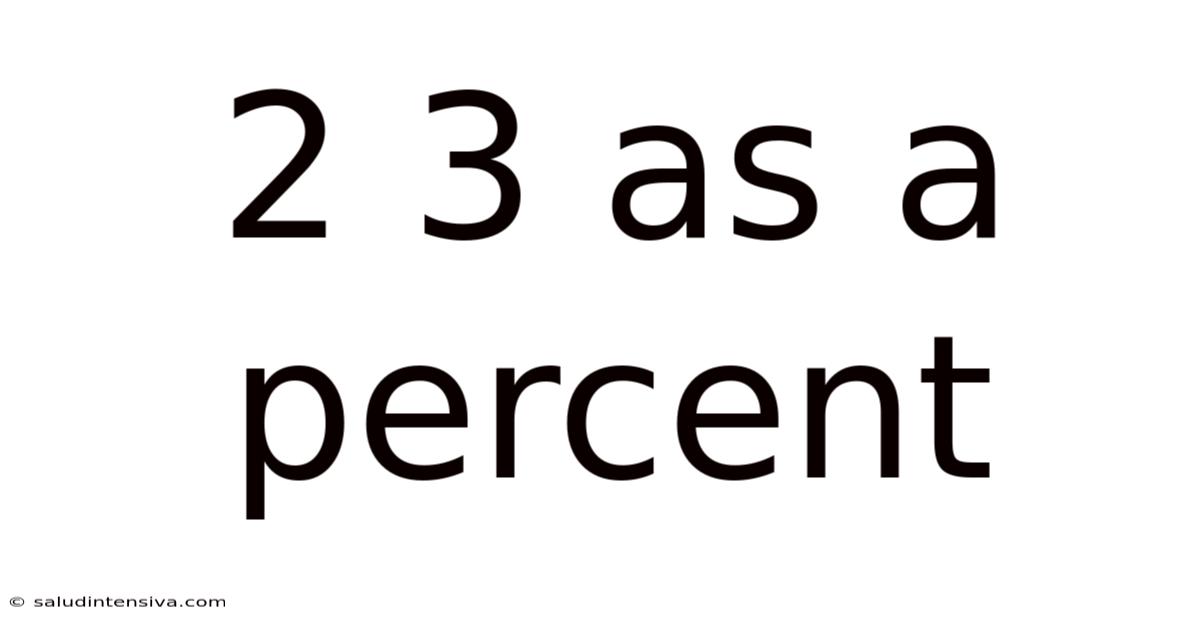2 3 As A Percent
saludintensiva
Sep 11, 2025 · 4 min read

Table of Contents
Understanding 2/3 as a Percentage: A Comprehensive Guide
Representing fractions as percentages is a fundamental skill in mathematics with broad applications in everyday life, from calculating discounts and interest rates to understanding statistics and data analysis. This comprehensive guide will explore how to convert the fraction 2/3 into a percentage, delve into the underlying concepts, and provide practical examples to solidify your understanding. We'll also tackle common questions and misconceptions surrounding this conversion.
Introduction: Fractions, Decimals, and Percentages – The Interconnected Trio
Before diving into the specifics of converting 2/3 to a percentage, let's establish a solid foundation. These three concepts – fractions, decimals, and percentages – are closely related and represent different ways of expressing parts of a whole.
-
Fractions: Fractions represent a part of a whole using a numerator (the top number) and a denominator (the bottom number). For example, 2/3 means 2 parts out of a total of 3 parts.
-
Decimals: Decimals represent parts of a whole using a base-ten system. They are expressed using a decimal point, separating the whole number from the fractional part.
-
Percentages: Percentages represent parts of a whole as a proportion of 100. The symbol "%" denotes "per hundred". So, 50% means 50 out of 100, or half.
The key to converting between these forms lies in understanding that they are all interchangeable representations of the same value.
Method 1: Converting the Fraction to a Decimal, Then to a Percentage
This is arguably the most straightforward method. It involves two simple steps:
-
Convert the fraction to a decimal: To convert 2/3 to a decimal, divide the numerator (2) by the denominator (3): 2 ÷ 3 = 0.66666... Notice that this is a recurring decimal, meaning the digit 6 repeats infinitely. We can round this to a certain number of decimal places for practical purposes.
-
Convert the decimal to a percentage: To convert a decimal to a percentage, multiply the decimal by 100 and add the percent sign (%). So, 0.6666... × 100 ≈ 66.67%. Again, rounding is necessary here. We commonly round to two decimal places for percentages.
Therefore, 2/3 is approximately equal to 66.67%.
Method 2: Using the Proportion Method
This method directly relates the fraction to the percentage using a proportion. We set up a proportion where the fraction 2/3 is equal to x/100, where 'x' represents the percentage we're looking for:
2/3 = x/100
To solve for 'x', we cross-multiply:
3x = 200
x = 200/3
x ≈ 66.67
Thus, using the proportion method, we again arrive at approximately 66.67%.
Understanding Recurring Decimals and Rounding
The conversion of 2/3 to a percentage involves a recurring decimal (0.6666...). This means the digit 6 repeats infinitely. In practical applications, we need to round this decimal to a manageable number of decimal places. The level of precision required depends on the context. For most everyday purposes, rounding to two decimal places (66.67%) is sufficient. However, in scientific or engineering calculations, more decimal places might be needed. It’s important to be aware of the inherent approximation when rounding recurring decimals.
Practical Applications of 2/3 as a Percentage
Understanding 2/3 as a percentage has various practical uses:
-
Sales and Discounts: If a store offers a 2/3 discount, it means a 66.67% discount.
-
Financial Calculations: Calculating interest, profit margins, or tax rates often involves working with fractions and percentages.
-
Data Analysis: In statistics, representing data as percentages helps in easier interpretation and comparison.
-
Everyday Life: Dividing tasks or resources fairly might involve using fractions that need converting into percentages for clarity.
Frequently Asked Questions (FAQ)
-
Q: Is 66.67% the exact equivalent of 2/3?
- A: No, 66.67% is an approximation of 2/3. The exact decimal representation of 2/3 is a recurring decimal (0.6666...), which cannot be represented perfectly as a finite decimal or percentage.
-
Q: Why do we round the percentage?
- A: We round the percentage for practicality. Recurring decimals are cumbersome to work with in most everyday calculations. Rounding allows us to use a manageable approximation.
-
Q: What happens if I need a more precise percentage than 66.67%?
- A: You can increase the number of decimal places in your approximation. For example, you could use 66.6667% or even more decimal places depending on the required level of accuracy. However, it's important to remember that you will always have an approximation for this fraction.
-
Q: Can I express 2/3 as a percentage without using decimals?
- A: While you can't avoid the decimal entirely in the calculation, you can express the result as a mixed number: 66⅔%. This represents the exact value, avoiding rounding errors.
Conclusion: Mastering the Conversion
Converting fractions to percentages is a valuable skill, particularly when dealing with 2/3 which yields a recurring decimal. Understanding the methods outlined above, along with the implications of rounding recurring decimals, will equip you to confidently tackle similar conversions and apply them to various practical scenarios. Remember that while we use approximations for practical purposes, it's crucial to understand the concept of the infinitely repeating decimal inherent to 2/3, allowing for precision when it is necessary. The ability to convert between fractions, decimals, and percentages enhances your mathematical fluency and problem-solving abilities across various disciplines.
Latest Posts
Latest Posts
-
5 To The Power 4
Sep 11, 2025
-
What Is Half Of 13
Sep 11, 2025
-
Terminating Or Repeating Decimal Calculator
Sep 11, 2025
-
To The 2 3 Power
Sep 11, 2025
-
Calculate Interquartile Range In Excel
Sep 11, 2025
Related Post
Thank you for visiting our website which covers about 2 3 As A Percent . We hope the information provided has been useful to you. Feel free to contact us if you have any questions or need further assistance. See you next time and don't miss to bookmark.